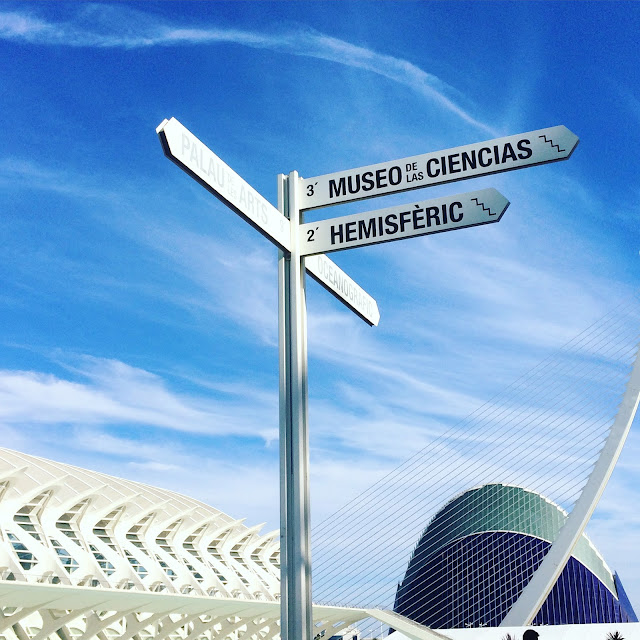Globally renowned for his technical take on the arts, Spanish architect Santiago Calatrava's works seem like they're from another world. His engineering background and fascination for osteology is evident in his architecture. They rise up from the ground like skeletal flowers, duplicated and repeated, or even suddenly mushrooming in odd shapes over his artificial landscapes.
He's designed so many iconic buildings all over the world, I've managed to visit a few (including Lisbon's Gare do Oriente) but my favourite has to be his City of Arts and Sciences in Valencia, Spain (which he designed along with Felix Candela).
A bit of my own background journey: Valencia is a four hour train ride from Barcelona. I bought a day return ticket for about 45 euros on the Renfe train website. From the Valencia's main train station, it's simply a 15 minute bus ride to the City of Arts and Sciences.
The Ciutat de les Arts i les Ciences (cey hehe) is basically a large compound with various buildings dedicated to arts, science, and culture. There's museums, pools, planetariums, an IMAX cinema, greenhouse, aquarium, an opera house and so much more! It's one of the 12 Treasures of Spain and is Valencia's most precious tourist attraction. To enter the compound and sightsee is completely free, but you'll have to pay if you want to participate in any of the activities. As it was my first time there I was just content to simply walk around, sit, and admire the crazzzyyy buildings around me!
For the Ciutat, construction took almost ten years to complete. It started in 1996, and once a building in the compound was completed, it was opened to the public. The last building completed, which was the Opera House "El Palau de les Arts Reina Sofia", opened in 2005.
While the whole project seems magical and futuristic (this is the location of the film Tomorrowland, and even an episode of Doctor Who), it isn't that simple. The complex has faced flooding and plumbing problems, it went way over budget as it costed 3 times more than the projected 300 million euros, and some critiques say that it's just an odd bit of land that doesn't really help the area around it (really like a theme park in the middle of nowhere). But I found that despite the criticisms, it does inspire awe and admiration from the millions of people who visit it every year.
It's always so refreshing to visit a building that's not a standard rectangular box, and to see how powerfully creative people realise their visions and push the boundaries of their field.
Calatrava's style is so iconic that he's inspired some projects much closer to our home, the bridges in Putrajaya :)
If your work is so successful that it elevates the standards of arts, science and culture worldwide, creates conversations, and provokes thought, it's already worth the money. This project put Valencia on the map :) I only wish that Malaysia would encourage more of this creativity for our future builders and constructers!
L'hemispheric, the planetarium.
Conical entrances going down to the walking / parking area. At the back, the opera house.
Interior of L'Umbracle - the greenhouse.
Structures of the interactive museum, El Museu de les Ciences Principe Felipe.
L'agora - a venue for concerts and sporting events.
The structure behind me is a cable bridge.
Beautiful!
You can read more about the architectural details and construction materials here : Arch 2 0 : City of Arts and Science
and go to the website here CAC





















0 comments:
Post a Comment